Yijun Wang
SelaFD:Seamless Adaptation of Vision Transformer Fine-tuning for Radar-based Human Activity
Feb 07, 2025



Abstract:Human Activity Recognition (HAR) such as fall detection has become increasingly critical due to the aging population, necessitating effective monitoring systems to prevent serious injuries and fatalities associated with falls. This study focuses on fine-tuning the Vision Transformer (ViT) model specifically for HAR using radar-based Time-Doppler signatures. Unlike traditional image datasets, these signals present unique challenges due to their non-visual nature and the high degree of similarity among various activities. Directly fine-tuning the ViT with all parameters proves suboptimal for this application. To address this challenge, we propose a novel approach that employs Low-Rank Adaptation (LoRA) fine-tuning in the weight space to facilitate knowledge transfer from pre-trained ViT models. Additionally, to extract fine-grained features, we enhance feature representation through the integration of a serial-parallel adapter in the feature space. Our innovative joint fine-tuning method, tailored for radar-based Time-Doppler signatures, significantly improves HAR accuracy, surpassing existing state-of-the-art methodologies in this domain. Our code is released at https://github.com/wangyijunlyy/SelaFD.
B-STaR: Monitoring and Balancing Exploration and Exploitation in Self-Taught Reasoners
Dec 23, 2024



Abstract:In the absence of extensive human-annotated data for complex reasoning tasks, self-improvement -- where models are trained on their own outputs -- has emerged as a primary method for enhancing performance. However, the critical factors underlying the mechanism of these iterative self-improving methods remain poorly understood, such as under what conditions self-improvement is effective, and what are the bottlenecks in the current iterations. In this work, we identify and propose methods to monitor two pivotal factors in this iterative process: (1) the model's ability to generate sufficiently diverse responses (exploration); and (2) the effectiveness of external rewards in distinguishing high-quality candidates from lower-quality ones (exploitation). Using mathematical reasoning as a case study, we begin with a quantitative analysis to track the dynamics of exploration and exploitation, discovering that a model's exploratory capabilities rapidly deteriorate over iterations, and the effectiveness of exploiting external rewards diminishes as well. Motivated by these findings, we introduce B-STaR, a Self-Taught Reasoning framework that autonomously adjusts configurations across iterations to Balance exploration and exploitation, thereby optimizing the self-improving effectiveness based on the current policy model and available rewards. Our experiments on mathematical reasoning, coding, and commonsense reasoning demonstrate that B-STaR not only enhances the model's exploratory capabilities throughout training but also achieves a more effective balance between exploration and exploitation, leading to superior performance.
Learning to Denoise Unreliable Interactions for Link Prediction on Biomedical Knowledge Graph
Dec 09, 2023



Abstract:Link prediction in biomedical knowledge graphs (KGs) aims at predicting unknown interactions between entities, including drug-target interaction (DTI) and drug-drug interaction (DDI), which is critical for drug discovery and therapeutics. Previous methods prefer to utilize the rich semantic relations and topological structure of the KG to predict missing links, yielding promising outcomes. However, all these works only focus on improving the predictive performance without considering the inevitable noise and unreliable interactions existing in the KGs, which limits the development of KG-based computational methods. To address these limitations, we propose a Denoised Link Prediction framework, called DenoisedLP. DenoisedLP obtains reliable interactions based on the local subgraph by denoising noisy links in a learnable way, providing a universal module for mining underlying task-relevant relations. To collaborate with the smoothed semantic information, DenoisedLP introduces the semantic subgraph by blurring conflict relations around the predicted link. By maximizing the mutual information between the reliable structure and smoothed semantic relations, DenoisedLP emphasizes the informative interactions for predicting relation-specific links. Experimental results on real-world datasets demonstrate that DenoisedLP outperforms state-of-the-art methods on DTI and DDI prediction tasks, and verify the effectiveness and robustness of denoising unreliable interactions on the contaminated KGs.
Visual tracking brain computer interface
Nov 21, 2023Abstract:Brain-computer interfaces (BCIs) offer a way to interact with computers without relying on physical movements. Non-invasive electroencephalography (EEG)-based visual BCIs, known for efficient speed and calibration ease, face limitations in continuous tasks due to discrete stimulus design and decoding methods. To achieve continuous control, we implemented a novel spatial encoding stimulus paradigm and devised a corresponding projection method to enable continuous modulation of decoded velocity. Subsequently, we conducted experiments involving 17 participants and achieved Fitt's ITR of 0.55 bps for the fixed tracking task and 0.37 bps for the random tracking task. The proposed BCI with a high Fitt's ITR was then integrated into two applications, including painting and gaming. In conclusion, this study proposed a visual BCI-based control method to go beyond discrete commands, allowing natural continuous control based on neural activity.
High-performance cVEP-BCI under minimal calibration
Nov 20, 2023Abstract:The ultimate goal of brain-computer interfaces (BCIs) based on visual modulation paradigms is to achieve high-speed performance without the burden of extensive calibration. Code-modulated visual evoked potential-based BCIs (cVEP-BCIs) modulated by broadband white noise (WN) offer various advantages, including increased communication speed, expanded encoding target capabilities, and enhanced coding flexibility. However, the complexity of the spatial-temporal patterns under broadband stimuli necessitates extensive calibration for effective target identification in cVEP-BCIs. Consequently, the information transfer rate (ITR) of cVEP-BCI under limited calibration usually stays around 100 bits per minute (bpm), significantly lagging behind state-of-the-art steady-state visual evoked potential-based BCIs (SSVEP-BCIs), which achieve rates above 200 bpm. To enhance the performance of cVEP-BCIs with minimal calibration, we devised an efficient calibration stage involving a brief single-target flickering, lasting less than a minute, to extract generalizable spatial-temporal patterns. Leveraging the calibration data, we developed two complementary methods to construct cVEP temporal patterns: the linear modeling method based on the stimulus sequence and the transfer learning techniques using cross-subject data. As a result, we achieved the highest ITR of 250 bpm under a minute of calibration, which has been shown to be comparable to the state-of-the-art SSVEP paradigms. In summary, our work significantly improved the cVEP performance under few-shot learning, which is expected to expand the practicality and usability of cVEP-BCIs.
Breathing Life into Faces: Speech-driven 3D Facial Animation with Natural Head Pose and Detailed Shape
Oct 31, 2023



Abstract:The creation of lifelike speech-driven 3D facial animation requires a natural and precise synchronization between audio input and facial expressions. However, existing works still fail to render shapes with flexible head poses and natural facial details (e.g., wrinkles). This limitation is mainly due to two aspects: 1) Collecting training set with detailed 3D facial shapes is highly expensive. This scarcity of detailed shape annotations hinders the training of models with expressive facial animation. 2) Compared to mouth movement, the head pose is much less correlated to speech content. Consequently, concurrent modeling of both mouth movement and head pose yields the lack of facial movement controllability. To address these challenges, we introduce VividTalker, a new framework designed to facilitate speech-driven 3D facial animation characterized by flexible head pose and natural facial details. Specifically, we explicitly disentangle facial animation into head pose and mouth movement and encode them separately into discrete latent spaces. Then, these attributes are generated through an autoregressive process leveraging a window-based Transformer architecture. To augment the richness of 3D facial animation, we construct a new 3D dataset with detailed shapes and learn to synthesize facial details in line with speech content. Extensive quantitative and qualitative experiments demonstrate that VividTalker outperforms state-of-the-art methods, resulting in vivid and realistic speech-driven 3D facial animation.
Decoding Natural Images from EEG for Object Recognition
Aug 25, 2023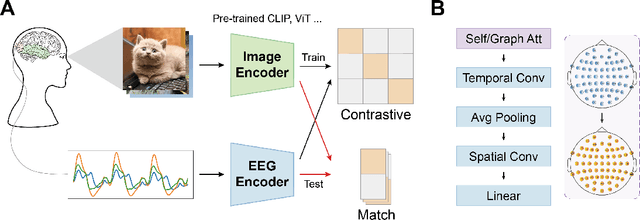


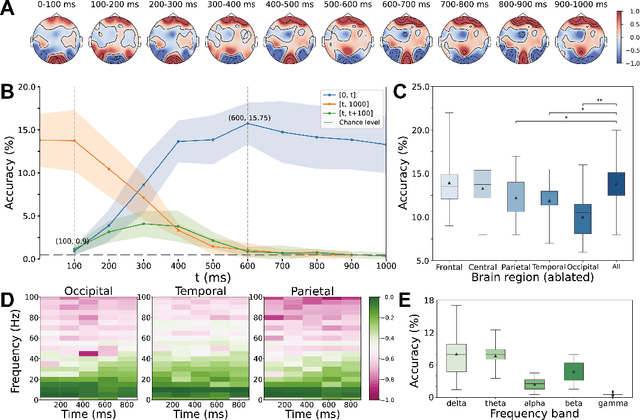
Abstract:Electroencephalogram (EEG) is a brain signal known for its high time resolution and moderate signal-to-noise ratio. Whether natural images can be decoded from EEG has been a hot issue recently. In this paper, we propose a self-supervised framework to learn image representations from EEG signals. Specifically, image and EEG encoders are first used to extract features from paired image stimuli and EEG responses. Then we employ contrastive learning to align these two modalities by constraining their similarity. Additionally, we introduce two plug-in-play modules that capture spatial correlations before the EEG encoder. Our approach achieves state-of-the-art results on the most extensive EEG-image dataset, with a top-1 accuracy of 15.6% and a top-5 accuracy of 42.8% in 200-way zero-shot tasks. More importantly, extensive experiments analyzing the temporal, spatial, spectral, and semantic aspects of EEG signals demonstrate good biological plausibility. These results offer valuable insights for neural decoding and real-world applications of brain-computer interfaces. The code will be released on https://github.com/eeyhsong/NICE-EEG.
Estimating and approaching maximum information rate of noninvasive visual brain-computer interface
Aug 25, 2023Abstract:The mission of visual brain-computer interfaces (BCIs) is to enhance information transfer rate (ITR) to reach high speed towards real-life communication. Despite notable progress, noninvasive visual BCIs have encountered a plateau in ITRs, leaving it uncertain whether higher ITRs are achievable. In this study, we investigate the information rate limits of the primary visual channel to explore whether we can and how we should build visual BCI with higher information rate. Using information theory, we estimate a maximum achievable ITR of approximately 63 bits per second (bps) with a uniformly-distributed White Noise (WN) stimulus. Based on this discovery, we propose a broadband WN BCI approach that expands the utilization of stimulus bandwidth, in contrast to the current state-of-the-art visual BCI methods based on steady-state visual evoked potentials (SSVEPs). Through experimental validation, our broadband BCI outperforms the SSVEP BCI by an impressive margin of 7 bps, setting a new record of 50 bps. This achievement demonstrates the possibility of decoding 40 classes of noninvasive neural responses within a short duration of only 0.1 seconds. The information-theoretical framework introduced in this study provides valuable insights applicable to all sensory-evoked BCIs, making a significant step towards the development of next-generation human-machine interaction systems.
DiffColor: Toward High Fidelity Text-Guided Image Colorization with Diffusion Models
Aug 03, 2023



Abstract:Recent data-driven image colorization methods have enabled automatic or reference-based colorization, while still suffering from unsatisfactory and inaccurate object-level color control. To address these issues, we propose a new method called DiffColor that leverages the power of pre-trained diffusion models to recover vivid colors conditioned on a prompt text, without any additional inputs. DiffColor mainly contains two stages: colorization with generative color prior and in-context controllable colorization. Specifically, we first fine-tune a pre-trained text-to-image model to generate colorized images using a CLIP-based contrastive loss. Then we try to obtain an optimized text embedding aligning the colorized image and the text prompt, and a fine-tuned diffusion model enabling high-quality image reconstruction. Our method can produce vivid and diverse colors with a few iterations, and keep the structure and background intact while having colors well-aligned with the target language guidance. Moreover, our method allows for in-context colorization, i.e., producing different colorization results by modifying prompt texts without any fine-tuning, and can achieve object-level controllable colorization results. Extensive experiments and user studies demonstrate that DiffColor outperforms previous works in terms of visual quality, color fidelity, and diversity of colorization options.
EMoG: Synthesizing Emotive Co-speech 3D Gesture with Diffusion Model
Jun 20, 2023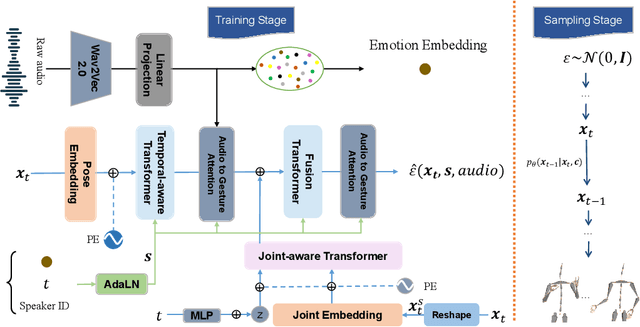
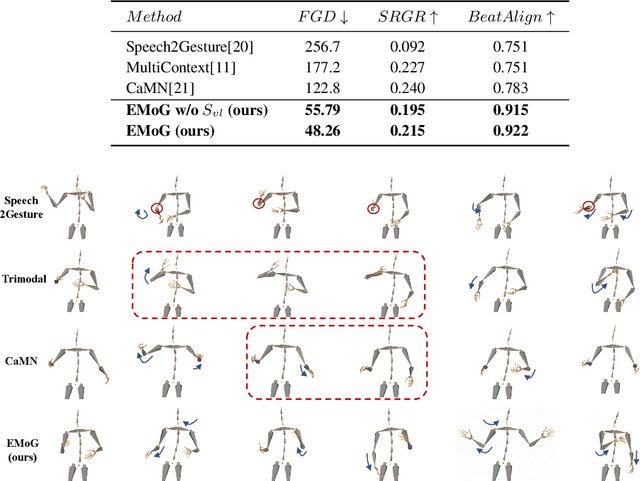
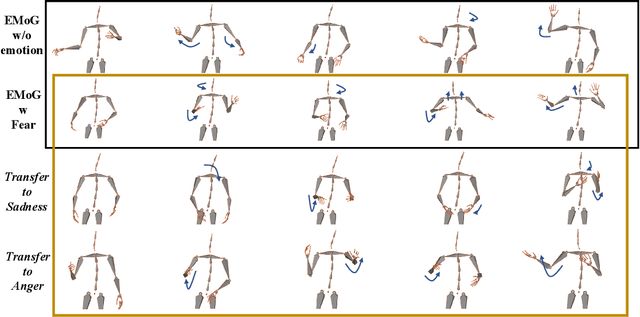

Abstract:Although previous co-speech gesture generation methods are able to synthesize motions in line with speech content, it is still not enough to handle diverse and complicated motion distribution. The key challenges are: 1) the one-to-many nature between the speech content and gestures; 2) the correlation modeling between the body joints. In this paper, we present a novel framework (EMoG) to tackle the above challenges with denoising diffusion models: 1) To alleviate the one-to-many problem, we incorporate emotion clues to guide the generation process, making the generation much easier; 2) To model joint correlation, we propose to decompose the difficult gesture generation into two sub-problems: joint correlation modeling and temporal dynamics modeling. Then, the two sub-problems are explicitly tackled with our proposed Joint Correlation-aware transFormer (JCFormer). Through extensive evaluations, we demonstrate that our proposed method surpasses previous state-of-the-art approaches, offering substantial superiority in gesture synthesis.
 Add to Chrome
Add to Chrome Add to Firefox
Add to Firefox Add to Edge
Add to Edge